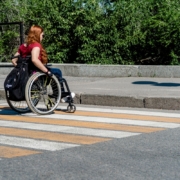Gamechangers That Have Shaped the Disability World
In the past, people with disabilities weren’t always accepted into society. It wasn’t until the 20th century that the physically and mentally disabled gained support. In the 1930s, the League for the Physically Handicapped was formed, helping to fight for employment rights during the Great Depression. Over the next few decades, advocacy groups and legislation would pave the way to the Americans with Disabilities Act of 1990 (ADA). Since then, ADA compliance has been a requirement for employers and businesses serving the public.
The ADA
There were laws and policies promoting inclusion of people with disabilities since the mid-19th century, but it was the ADA that provided civil rights reform to prevent discrimination. It focused on inclusion and nondiscrimination based on disability regarding employment, access to government services, and use of public accommodations.
It was amended in 2008 to expand the scope of individuals who fit its definition, and it continues to be the standard for equal employment opportunities, community participation, independent living, and economic self-sufficiency.
Employers and facilities that don’t meet ADA compliance requirements are provided with opportunities to make improvements. If they don’t when doing so is within reason, they can be heavily fined and otherwise penalized.
Inventions
The following inventions have reshaped the world for people with disabilities.

- Braille: Invented by Louis Braille, this tactile writing system for the visually impaired began as a code for the French alphabet in 1824 and was revised in 1837 as a binary system. Originally, braille was based on night writing, a military code used by Napoleon’s soldiers to communicate in the dark.
It consists of raised dots within rectangular blocks called cells. English braille encodes printed writing, illustrations, graphs, and musical notation. Today, refreshable electronic braille displays allow visually impaired individuals to use computers and even write in braille using specialized equipment.
- Smartphone Apps: Smartphones have become invaluable tools for people with disabilities. A number of applications are available, including an interactive camera app that helps children with autism make eye contact, and iPhone and iPad apps that allow those with nonverbal conditions to interact with loved ones and strangers using natural sounding voices and word prediction for fast typing.
There is also a font for helping people with dyslexia read and an app that lets people with visual impairments take videos that sighted volunteers can access and describe to them.
- Truncated Domes: Invented in 1965 by Seiichi Miyake, truncated domes became the foundation of tactile warning surfaces now used on sidewalks, transportation platforms, and pedestrian thoroughfares in many countries. They can be felt under the feet and by anyone using a cane, walker, or wheelchair, so it’s possible to tell when someone may be near an area that transitions into a street or where a staircase or ramp begins and ends. The ADA includes specific guidelines for the dimensions, spacing, and color of truncated domes.
Order Tactile Warning Systems from ADA Solutions
We design, manufacture, and supply warning tiles with truncated domes and other tactile warnings. Cast-in-place, surface-applied, and radius systems are available. All products are designed to meet ADA requirements for any business in which ADA applicability is a factor. Request a free quote or call 800-372-0519 today.












